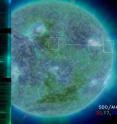Strong evidence for coronal heating theory presented at 2015 TESS meeting
The sun's surface is blisteringly hot at 10,340 degrees Fahrenheit -- but its atmosphere is another 300 times hotter. This has led to an enduring mystery for those who study the sun: What heats the atmosphere to such extreme temperatures? Normally when you move away from a hot source the environment gets cooler, but some mechanism is clearly at work in the solar atmosphere, the corona, to bring the temperatures up so high. Clear evidence now suggests that the heating mechanism depends on regular, but intermittent explosive bursts of heat, rather than on continuous gradual heating. This solution to the coronal heating mystery was presented in a media briefing on April 28, 2015, at the Triennial Earth-Sun Summit, or TESS, meeting in Indianapolis, Indiana.
This is the inaugural meeting for TESS, which is a first of its kind: uniting the various research groups that study the sun-Earth connection from explosions on the sun to their effects near our home planet and all the way out to the edges of the solar system - a research field collectively known as heliophysics. The overarching goal is to share techniques across disciplines and encourage interdisciplinary collaboration on outstanding heliophysics questions.
The coronal heating mystery is one such outstanding question. Four scientists spoke at the media briefing.
Jim Klimchuk, a solar scientist at NASA's Goddard Space Flight Center in Greenbelt, Maryland, explained that the new evidence supports a theory that the sun's corona is heated by tiny explosions called nanoflares. These are impulsive heating bursts that individually reach incredibly hot temperatures of some 10 million Kelvins or 18 million degrees Fahrenheit - even greater than the average temperature of the corona - and provide heat to the atmosphere. The research evidence presented by the panel spotted this super hot solar material, called plasma, representative of a nanoflare.
"The explosions are called nanoflares because they have one-billionth the energy of a regular flare," said Klimchuk. "Despite being tiny by solar standards, each packs the wallop of a 10 megaton hydrogen bomb. Millions of them are going off every second across the sun, and collectively they heat the corona."
The first evidence of the presence of this super hot plasma was presented by Adrian Daw, a solar scientist at Goddard and principal investigator of the Extreme Ultraviolet Normal Incidence Spectrograph, or EUNIS, sounding rocket mission. EUNIS flew on a 15-minute flight in December 2013 equipped with an instrument called a spectrograph, which can gather information about how much material is present at a given temperature. The EUNIS spectrograph was tuned into a range of wavelengths useful for spotting material at temperatures of 18 million F, the temperatures that signify nanoflares. The spectrograph unambiguously spotted this extremely hot material in active regions that visibly appeared to be quiet. In a quiet region, such hot temperatures clearly weren't due to a large explosive solar flare, and so are a smoking gun that something otherwise unobservable was heating up this area.
Daw also reported the results from another experiment launched on sounding rockets in 2012 and 2013 that imaged soft X-rays from the corona. These results, too, confirmed the presence of super hot plasma on the sun.
Iain Hannah, an astrophysicist at the University of Glasgow in Scotland, spoke about NASA's Nuclear Spectroscopic Telescope Array, or NuSTAR, which typically examines X-rays from distant stars and black holes. However, it is also capable of observing the much brighter light of the sun - something most astronomical observatories can't do.
"X-rays are a direct probe into the high-energy processes of the sun," said Hannah.
NuSTAR saw X-rays that are signatures of super hot plasma in non-flaring active regions. While the sounding rocket experiments observed the energy produced by these nanoflares, NuSTAR is also able to look for the X-ray signatures of energetic particles. Understanding what and how particles are accelerated out from these smaller nanoflare explosions can help scientists understand what processes create them.
Stephen Bradshaw, a solar astrophysicist at Rice University in Houston, Texas, was the last speaker. Bradshaw used a sophisticated computational model to demonstrate why spotting signatures of the nanoflares has been so difficult and how the new evidence will help researchers go forward to improve theories on the details of coronal heating - one day allowing heliophysics researchers to at last solve the coronal heating mystery.
The TESS meeting will occur every three years and is a joint meeting of the Space Physics and Aeronomy Section of the American Geophysical Union and the Solar Physics Division of the American Astronomical Society.
Source: NASA/Goddard Space Flight Center
Other sources
- Scientists present evidence for coronal heating theoryfrom UPIWed, 29 Apr 2015, 19:30:11 UTC
- Strong evidence for coronal heating theoryfrom Science DailyWed, 29 Apr 2015, 15:00:11 UTC
- Tiny explosions add up to heat coronafrom Sciencenews.orgWed, 29 Apr 2015, 10:10:05 UTC
- Mystery of sun's corona solved? It's nanoflares, scientists sayfrom LA Times - ScienceTue, 28 Apr 2015, 19:50:49 UTC
- Millions of H-bomb-sized explosions heat sun's coronafrom CBSNews - ScienceTue, 28 Apr 2015, 18:40:03 UTC
- Strong evidence for coronal heating theory presentedfrom PhysorgTue, 28 Apr 2015, 17:20:31 UTC
